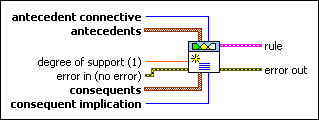 |
antecedent connective specifies how this VI calculates the truth value of the aggregated rule antecedent.
| 0 | AND (Minimum)—Specifies that this VI uses the smallest degree of membership of the antecedents. | | 1 | AND (Product)—Specifies that this VI uses the product of the degrees of membership of the antecedents. | | 2 | OR (Maximum)—Specifies that this VI uses the largest degree of membership of the antecedents. | | 3 | OR (Probabilistic)—Specifies that this VI uses the probabilistic sum of the degrees of membership of the antecedents. The fuzzy logic controller uses the following equation to calculate the probabilistic sum: (A + B) – (A * B), where A and B are the antecedents. |
|
 |
antecedents specifies the antecedents, or IF portions, of the rule. Each antecedent consists of three parts: the index of an input linguistic variable, an operator that specifies whether to calculate the degree of membership or the degree of non-membership of the input linguistic variable within a linguistic term, and the index of the linguistic term. The indexes correspond to the order in which the variables or linguistic terms were created.
You can use the Build Array function or a loop to build an array of rule antecedents that you create with the FL Create Antecedent VI. You then can wire the array to this input.
|
 |
degree of support specifies the weight, between 0 and 1, that you want to apply to the rule. The default is 1. Multiply the degree of support by the truth value of the aggregated rule antecedent to calculate the rule weight.
|
 |
error in describes error conditions that occur before this node runs. This input provides standard error in functionality.
|
 |
consequents specifies the consequents, or THEN portions, of the rule. Each consequent consists of three parts: the index of an output linguistic variable, an operator that specifies whether to calculate the degree of membership or the degree of non-membership of the output linguistic variable within a linguistic term, and the index of the linguistic term. The indexes correspond to the order in which the variables or linguistic terms were created.
You can use the Build Array function or a loop to build an array of rule consequents that you create with the FL Create Consequent VI. You then can wire the array to this input.
|
 |
consequent implication specifies the implication method this VI uses to scale the membership functions of the output linguistic variable based on the rule weight.
| 0 | Minimum—Specifies to use the Minimum implication method. | | 1 | Product—Specifies to use the Product implication method. |
|
 |
rule returns the rule with the antecedents, consequents, and relationships you specify.
|
 |
error out contains error information. This output provides standard error out functionality.
|

 Add to the block diagram
Add to the block diagram Find on the palette
Find on the palette




